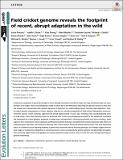Files in this item
Field cricket genome reveals the footprint of recent, abrupt adaptation in the wild
Item metadata
| dc.contributor.author | Pascoal, Sonia | |
| dc.contributor.author | Risse, Judith E. | |
| dc.contributor.author | Zhang, Xiao | |
| dc.contributor.author | Blaxter, Mark | |
| dc.contributor.author | Cezard, Timothee | |
| dc.contributor.author | Challis, Richard J. | |
| dc.contributor.author | Gharbi, Karim | |
| dc.contributor.author | Hunt, John | |
| dc.contributor.author | Kumar, Sujai | |
| dc.contributor.author | Langan, Emma | |
| dc.contributor.author | Liu, Xuan | |
| dc.contributor.author | Rayner, Jack G. | |
| dc.contributor.author | Ritchie, Michael G. | |
| dc.contributor.author | Snoek, Basten L. | |
| dc.contributor.author | Trivedi, Urmi | |
| dc.contributor.author | Bailey, Nathan William | |
| dc.date.accessioned | 2019-12-20T11:30:01Z | |
| dc.date.available | 2019-12-20T11:30:01Z | |
| dc.date.issued | 2020-02-07 | |
| dc.identifier | 263391194 | |
| dc.identifier | 87daef75-e43f-4727-8cf2-17df860faac7 | |
| dc.identifier | 000504077900001 | |
| dc.identifier | 85085379980 | |
| dc.identifier.citation | Pascoal , S , Risse , J E , Zhang , X , Blaxter , M , Cezard , T , Challis , R J , Gharbi , K , Hunt , J , Kumar , S , Langan , E , Liu , X , Rayner , J G , Ritchie , M G , Snoek , B L , Trivedi , U & Bailey , N W 2020 , ' Field cricket genome reveals the footprint of recent, abrupt adaptation in the wild ' , Evolution Letters , vol. 4 , no. 1 , pp. 19-33 . https://doi.org/10.1002/evl3.148 | en |
| dc.identifier.issn | 2056-3744 | |
| dc.identifier.other | ORCID: /0000-0001-7913-8675/work/66398358 | |
| dc.identifier.other | ORCID: /0000-0003-3531-7756/work/66398502 | |
| dc.identifier.other | ORCID: /0000-0003-1996-8313/work/86987215 | |
| dc.identifier.uri | https://hdl.handle.net/10023/19174 | |
| dc.description | The Natural Environment Research Council provided funding to N.W.B. (NE/G014906/1, NE/L011255/1) and to N.W.B. and M.G.R. (NE/1027800/1). Sequencing was provided by Edinburgh Genomics and the Centre for Genomic Research (University of Liverpool). Bioinformatics resources at St Andrews were funded by the Wellcome Trust (105621/Z/14/Z). Support from the China Scholarship Council (201703780018) to X.Z. is gratefully acknowledged. The Biotechnology and Biological Sciences Research Council provided support to M.B. for development of ChirpBase (BB/K020161/1). | en |
| dc.description.abstract | Evolutionary adaptation is generally thought to occur through incremental mutational steps, but large mutational leaps can occur during its early stages. These are challenging to study in nature due to the difficulty of observing new genetic variants as they arise and spread, but characterizing their genomic dynamics is important for understanding factors favoring rapid adaptation. Here, we report genomic consequences of recent, adaptive song loss in a Hawaiian population of field crickets (Teleogryllus oceanicus). A discrete genetic variant, flatwing, appeared and spread approximately 15 years ago. Flatwing erases sound‐producing veins on male wings. These silent flatwing males are protected from a lethal, eavesdropping parasitoid fly. We sequenced, assembled and annotated the cricket genome, produced a linkage map, and identified a flatwing quantitative trait locus covering a large region of the X chromosome. Gene expression profiling showed that flatwing is associated with extensive genome‐wide effects on embryonic gene expression. We found that flatwing male crickets express feminized chemical pheromones. This male feminizing effect, on a different sexual signaling modality, is genetically associated with the flatwing genotype. Our findings suggest that the early stages of evolutionary adaptation to extreme pressures can be accompanied by greater genomic and phenotypic disruption than previously appreciated, and highlight how abrupt adaptation might involve suites of traits that arise through pleiotropy or genomic hitchhiking. | |
| dc.format.extent | 15 | |
| dc.format.extent | 1240795 | |
| dc.language.iso | eng | |
| dc.relation.ispartof | Evolution Letters | en |
| dc.subject | Adaptation | en |
| dc.subject | Feminization | en |
| dc.subject | Genomics | en |
| dc.subject | Rapid evolution | en |
| dc.subject | Sexual signaling | en |
| dc.subject | Trait loss | en |
| dc.subject | QH301 Biology | en |
| dc.subject | 3rd-DAS | en |
| dc.subject | BDC | en |
| dc.subject | R2C | en |
| dc.subject | ~DC~ | en |
| dc.subject.lcc | QH301 | en |
| dc.title | Field cricket genome reveals the footprint of recent, abrupt adaptation in the wild | en |
| dc.type | Journal article | en |
| dc.contributor.sponsor | NERC | en |
| dc.contributor.sponsor | NERC | en |
| dc.contributor.sponsor | NERC | en |
| dc.contributor.sponsor | The Wellcome Trust | en |
| dc.contributor.institution | University of St Andrews. School of Biology | en |
| dc.contributor.institution | University of St Andrews. Centre for Biological Diversity | en |
| dc.contributor.institution | University of St Andrews. Institute of Behavioural and Neural Sciences | en |
| dc.identifier.doi | https://doi.org/10.1002/evl3.148 | |
| dc.description.status | Peer reviewed | en |
| dc.identifier.grantnumber | Ne/I027800/1 | en |
| dc.identifier.grantnumber | NE/G014906/1 | en |
| dc.identifier.grantnumber | NE/L011255/1 | en |
| dc.identifier.grantnumber | 105621/Z/14/Z | en |
This item appears in the following Collection(s)
Items in the St Andrews Research Repository are protected by copyright, with all rights reserved, unless otherwise indicated.

